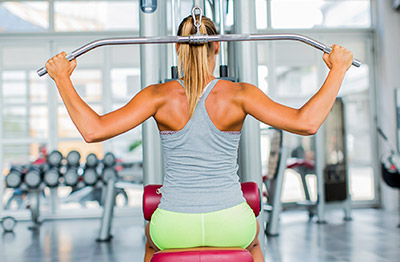 Your spine—it’s so important as the conduit for your central nervous system, which lets you move. And feel! From neck to tailbone, this is a body part you don’t want to mess around with.
Your spine—it’s so important as the conduit for your central nervous system, which lets you move. And feel! From neck to tailbone, this is a body part you don’t want to mess around with.
There are plenty of attachments to the spine to protect as well. It’s best not to overdo it and hurt your back, or worse, to injure your spine at the gym. Use these tips to avoid a “bad back.”
- Work your whole body. It’s a catch 22 that while you’re working hard in one area, you might be putting another area at risk—if the loads are too heavy or your workout is imbalanced, it’s easy to end up straining your back. A classic example is workouts for isolated muscle groups. If you’re pushing your upper body work, your spine may flex, extend or twist in ways it doesn’t like, in order to compensate.
TIP: Be sure yours is a full body regime with plenty of compound moves like barbell squats and deadlifts that build total body strength.
- Engage your abs. You may realize that all core exercises rely on your back in some way. Similarly, all strength exercises should rely on your core, which includes the collection of muscles in your back and attachments to the spine. You help strengthen and protect your spine when you learn to engage your abdominals to support your movement.
TIP: Tighten your midsection as if you were zipping into a wetsuit (or some will say, as if you’re about to take a punch to the gut). This will activate ab muscles that work with your back.
- Connect with your back. Your spine consists of five sections, with the greatest length coming from a combo of your lumbar (lower back), thoracic (middle back) and cervical (neck) regions. These three sections are also susceptible to injury because of how mobile they are – they need stability to avoid shifting and pinching. You can stabilize your spine with the right attention to positions of your head, shoulders, ribcage and hips during workouts.
TIP: Tighten your glutes as if you were doing “butt crunches” (or some will say, is if you have to go to the bathroom), connect your low back and hips to help stabilize the lumbar spine.
- Lengthen your spine. When you think about all the disks and nerves along your spinal cord, you realize you don’t want them compressed, tilted or pinched. Working out with proper posture and a strong spine is the form to achieve. This means you don’t want a rounded, flexed back during upper body work or a hyperextended, arched back during lower body work.
TIP: Think of pulling up and getting taller from your midsection, not from your head or chest. There’s a difference between straight posture and a stiff back.


